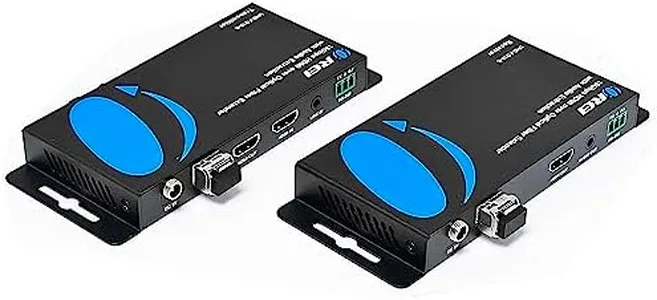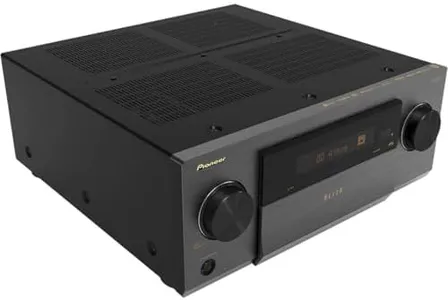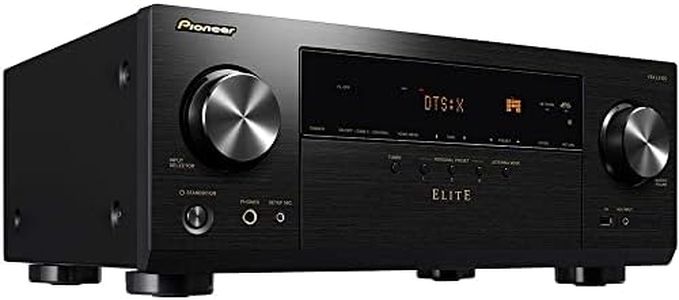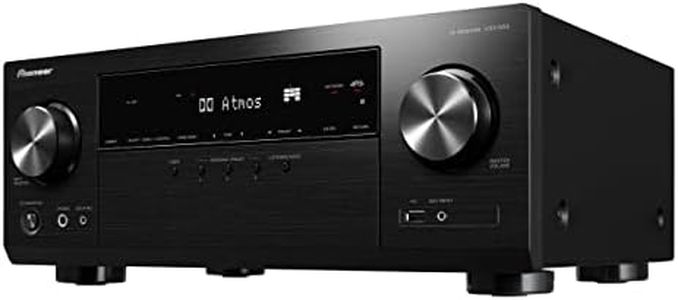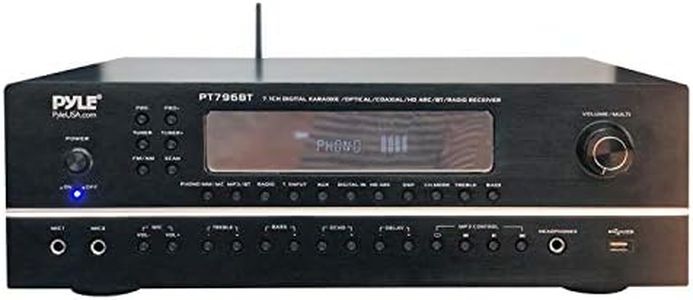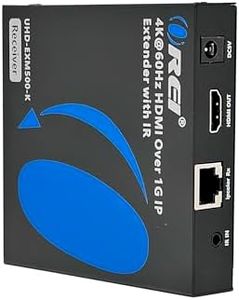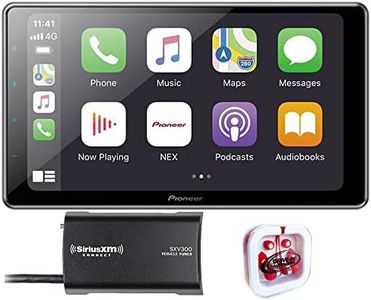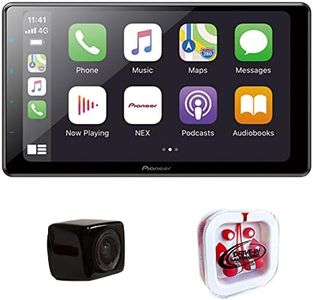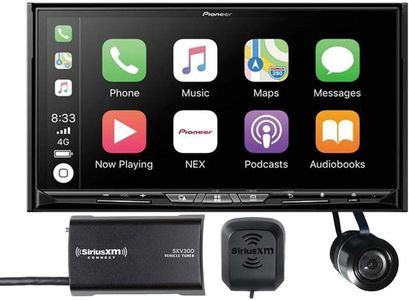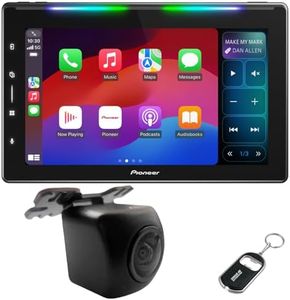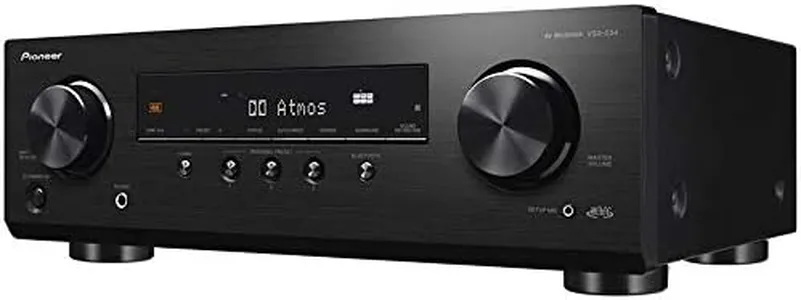10 Best Pioneer Receivers 2025 in the United States
Our technology thoroughly searches through the online shopping world, reviewing hundreds of sites. We then process and analyze this information, updating in real-time to bring you the latest top-rated products. This way, you always get the best and most current options available.

Our Top Picks
Winner
Pioneer Elite VSX-LX805 11.4 Channel AV Receiver
Most important from
10 reviews
The Pioneer Elite VSX-LX805 11.4 Channel AV Receiver is a robust and feature-packed AV receiver. With 150 watts per channel across 11 channels, it supports powerful and immersive audio setups, particularly in a 7.2.4 configuration. This makes it ideal for users who want a high-performance home theater system capable of driving large speaker setups and delivering clear, powerful sound. The receiver can manage audio in three distinct zones simultaneously, which is great for multi-room audio experiences, catering to different preferences in various parts of the home.
The extensive connectivity options, including HDMI, RCA, Phono, Bluetooth, and Wi-Fi, allow for versatile and convenient connections to various devices and streaming platforms. This ensures you can easily integrate the receiver into your existing setup and enjoy high-quality audio from multiple sources. One of its standout features is the Dirac Live room calibration, which optimizes sound quality according to the room's acoustics, providing a tailored listening experience. The optional Bass Control upgrade further enhances this feature for bass enthusiasts. Additionally, the receiver supports cutting-edge audio formats such as Dolby Atmos and DTS-HD Master Audio, ensuring a cinema-like experience at home.
The inclusion of Ultra HD support, including 8K and 4K HDR, makes it future-proof and compatible with the latest high-definition video formats. However, this receiver is quite large and heavy, with dimensions of 22.05 x 22.05 x 14.17 inches and a weight of 47.4 pounds, which might be cumbersome for some setups. Its price point might also be a consideration for budget-conscious buyers. The user interface and setup can be complex for those who are not tech-savvy, potentially requiring a learning curve or professional installation to fully utilize its capabilities. Despite these minor drawbacks, the Pioneer Elite VSX-LX805 is a high-quality choice for audiophiles and home theater enthusiasts looking for a top-tier AV receiver.
Most important from
10 reviews
Pioneer AVIC-W8600NEX 7" Capacitive Touchscreen, 2-Din – GPS Navigation, Wireless & Wired Apple CarPlay & Android Auto, Bluetooth, CD/DVD, SD Card, USB, SiriusXM, HD Radio, Backup Camera, Hi-Volt RCA
Most important from
34 reviews
The Pioneer AVIC-W8600NEX 7" Touchscreen Multimedia Navigation Receiver is a versatile double-DIN head unit that excels in connectivity and smartphone integration. It supports both wired and wireless Apple CarPlay and Android Auto, making it very smartphone-friendly. The built-in Bluetooth functionality allows for hands-free calls and wireless audio streaming, enhancing convenience and safety on the road.
Additionally, the receiver features Amazon Alexa compatibility, enabling voice command control for various functions, which is particularly useful for staying focused while driving. The real-time navigation system with up-to-date maps and traffic information is a significant advantage for frequent travelers, and the dual-zone entertainment ensures that rear passengers can enjoy separate media content from the front passengers.
The unit is also prepared for rear camera installation, easing parking and reversing maneuvers. The Pioneer AVIC-W8600NEX stands out for its comprehensive connectivity options and practical features suited for enhancing in-car entertainment and navigation.
Most important from
34 reviews
Pioneer Elite VSX-LX105 7.2 Channel Network AV Receiver
Most important from
186 reviews
The Pioneer Elite VSX-LX105 is a versatile 7.2 channel AV receiver that offers strong appeal for home theater enthusiasts and gamers alike. Its standout feature is HDMI 2.1 support, enabling 8K video pass-through and 4K at 120Hz, which is great for future-proofing your setup and ensuring smooth, lag-free gaming with technologies like Variable Refresh Rate and Auto Low Latency Mode. The receiver supports popular high-quality audio formats including Dolby Atmos and DTS:X, delivering immersive sound that suits movies and music.
It also features MCACC auto room calibration, which helps tailor the sound to your specific listening environment by adjusting for room acoustics and speaker placement. Connectivity options are robust, with seven HDMI inputs, Bluetooth, and support for major streaming services (Spotify, Amazon Music, TIDAL, etc.) via built-in technologies like Chromecast and AirPlay 2. The user experience is enhanced by its compatibility with Roon for easy music management and a user-friendly interface.
Weighing around 21.6 pounds, the receiver is a solid mid-range option that balances modern gaming and high-resolution audio needs effectively, making it a strong choice for those looking to upgrade their home audio with future-ready features.
Most important from
186 reviews
Buying Guide for the Best Pioneer Receivers
When choosing a Pioneer receiver, it's important to consider your specific needs and preferences to ensure you get the best fit for your home audio setup. Receivers are the heart of your home theater system, connecting all your audio and video components and delivering high-quality sound. Here are some key specifications to consider when selecting a Pioneer receiver, along with explanations to help you understand their importance and how to choose the right one for you.FAQ
Most Popular Categories Right Now
